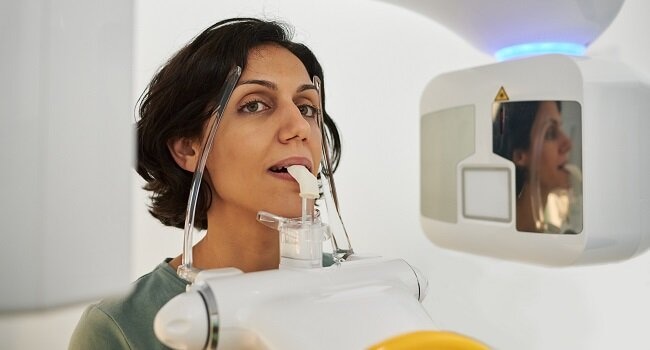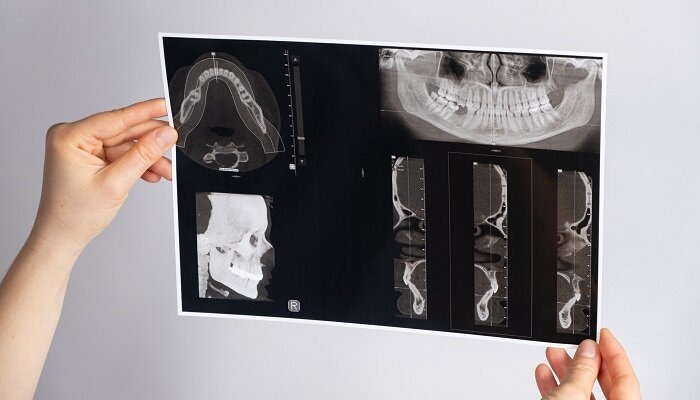Gone are the days of relying solely on two-dimensional X-rays for dental assessments. Dental cone-beam computed tomography (CBCT) scans have emerged as a transformative technology in dentistry, offering a three-dimensional perspective of the oral cavity.┬Ā
This advancement surpasses the limitations of traditional X-rays, providing dentists with a far more comprehensive view of teeth, jawbone, soft tissues, and nerves.
By exploring the advantages of dental CT scans over conventional methods, this article emphasizes their pivotal role in transforming dental care and patient outcomes.
What Are Dental CT Scans?
Dental computed tomography (CT) scans represent sophisticated imaging procedures that deliver intricate, three-dimensional (3D) visuals of the teeth, soft tissues, nerve routes, and bones within the craniofacial area.
These precision dental scans are particularly valuable in planning and diagnosis in dentistry for several reasons:
Implant Planning: Dental CT scans are essential in the preparation for dental implant procedures. They assist in evaluating the available bone’s quality and quantity for implants, guarantee proper placement, and help avoid important anatomical features such as nerves and sinuses.
Orthodontics: These scans play a crucial role in visualizing teeth and adjacent bone structures, assisting with the diagnosis and strategic planning for intricate cases.
Complex Endodontics: For complex root canal treatments, CT scans can identify the number of canals in a tooth, their shape, and whether any infection is present.
Diagnosis of Dental Pathologies: CT scans are effective in diagnosing tumors, cysts, and other pathologies in the jaw and surrounding tissues, offering a comprehensive view that regular dental X-rays might not provide.
Surgical Planning: They are indispensable in planning surgical procedures, such as impacted tooth extractions, reconstructive surgeries, and the assessment of facial traumas.
TMJ Analysis: CT scans provide intricate visuals of the temporomandibular joint (TMJ), aiding in the identification of disorders and the formulation of treatment plans.
These scans can be performed using specialized dental CT machines, such as cone beam computed tomography (CBCT) scanners, which are designed to minimize radiation exposure while providing precise images necessary for effective dental care planning and diagnosis.
Benefits of Dental CT Scans Over Traditional X-Rays
Dental CT scans, particularly those utilizing CBCT technology, offer several advantages over traditional dental X-rays, making them a powerful tool in modern dentistry for diagnosis, treatment planning, and patient care. Here are some of the key benefits:
Three-Dimensional Imaging: Dental CT scans provide three-dimensional (3D) images, offering a comprehensive view of the teeth, jawbone, soft tissues, and nerves. This contrasts with traditional X-rays, which only provide two-dimensional (2D) images. The 3D visualization aids in accurate diagnosis and treatment planning.
Improved Image Quality: CT scans offer high-resolution images, enabling the detection of conditions that may not be visible on traditional X-rays. This level of detail is crucial for identifying small lesions, intricate bone structures, and early signs of disease.
Accurate Implant Planning: The precision of CT scans is particularly beneficial for dental implant planning. It allows for the assessment of bone quality and quantity, precise implant placement, and avoidance of critical structures like nerves and sinuses.
Better Visualization of Complex Anatomy: CT scans excel at showing the spatial relationships and conditions of dental structures, which is essential for diagnosing and treating complex cases, such as impacted teeth, jaw tumors, and intricate root canal anatomy.
Efficient Treatment Planning: With the detailed information provided by CT scans, dentists and specialists can plan treatments more effectively. This includes orthodontic assessments, surgical interventions, and complex endodontic cases.
Minimized Radiation Exposure: Modern dental CT scanners, especially CBCT machines, are designed to minimize radiation exposure to the patient while still providing high-quality images. While CT scans generally involve more radiation than traditional dental X-rays, the use of CBCT technology significantly reduces this exposure compared to medical-grade CT scanners.
Time Efficiency: A dental CT scan can capture a comprehensive view of the entire craniofacial area in a single scan, reducing the time needed for multiple traditional X-rays and minimizing the patient’s exposure to radiation.
Cost-Effectiveness: While the initial cost for a CT scan might be higher than traditional X-rays, the detailed information it provides can lead to more efficient treatment planning, potentially reducing the need for additional diagnostic tests and follow-up procedures.
Dental CT scans provide superior imaging capabilities that enhance diagnostic accuracy, treatment planning, and patient safety, making them an invaluable tool in various dental specialties.
Takeaway
Dental CT scans have become an indispensable tool in modern dentistry. Their ability to provide detailed three-dimensional images has significantly improved diagnostic accuracy and treatment planning, ultimately leading to better patient care and outcomes.┬Ā

Embracing these advanced imaging techniques brightens the future of dentistry, promising more accurate diagnoses, effective treatments, and, ultimately, enhanced oral health for individuals.


















